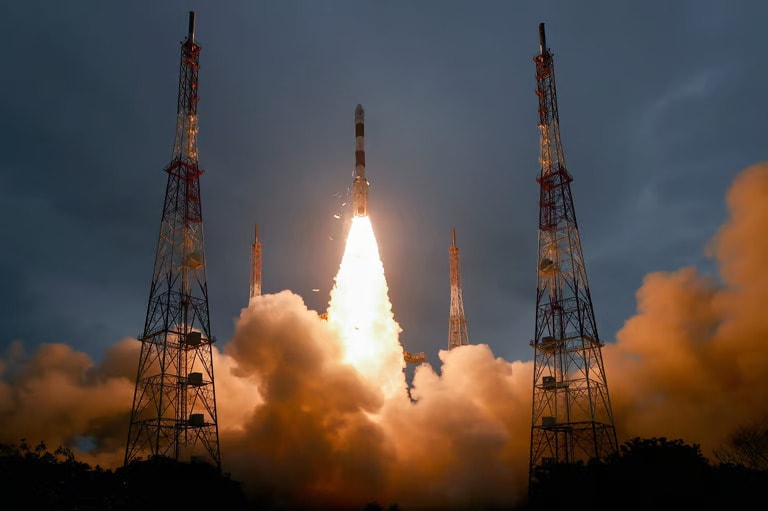By Lt Gen AK Bhatt (Retd.), and Akshat Johri
India’s space sector is at an inflection point, driven by unprecedented collaboration between public and private enterprises. This paradigm shift, catalyzed by the NSIL’s LVM3-launch vehicle Public-Private Partnership (PPP) model and now the launch of innovative Earth Observation Satellites (EOS) by IN-SPACe, is rapidly positioning the country as a global space leader. By merging strategic partnerships with advanced satellite technologies, the PPP initiative aims to unlock new opportunities for both established firms and startups, enabling India to harness the potential of space technology for critical applications across sectors such as disaster management, climate monitoring, and infrastructure development.
Earth Observation Satellites (EOS) have become essential tools for understanding our planet, driven by rapid advancements in space technology. These satellites, equipped with sophisticated sensors and instruments, provide valuable data on the Earth’s surface, atmosphere, and environment, which is critical for applications like weather forecasting, climate monitoring, disaster management, and urban planning. Climate Change is a global threat not just for India, but for the world and the demand for accurate and timely data grows, nations worldwide, including India. This underlines the growing importance of these technologies in addressing complex global challenges.
Recognizing the strategic value of EOS, India is pioneering a new Public-Private Partnership (PPP) model to enhance its satellite capabilities. IN-SPACe, the regulatory arm of India’s Space sector that has released an Expression of Interest that allows organizations in the Space Sector to collaborate and create a Build-Own-Operate constellation for EOS that will be built and launched from Indian soil. By integrating multiple advanced technologies, the model seeks to improve data dissemination capabilities and stimulate innovation, positioning India as a leader in the global satellite data market while also creating demand for its launch vehicles and strengthening the overall competitiveness of its space sector.
In 2022, the Earth Observation data market was valued at $4.6 billion, as per Euroconsult report, with substantial demand in North America, Europe and Asia, particularly for applications in natural resource monitoring, energy, infrastructure, environment, and defense. Globally, nations such as the United States and the European Union lead in EOS deployment, with the U.S. government entities like the National Reconnaissance Office (NRO) and Department of Defense (DOD) account for buying majority of the total value-added services (VAS) data of EOS. India’s push to capabilities comes at a critical time when the global demand for satellite-based data is surging, and lots of players providing VAS and EO services have joined in the last 5 years. Today, India has over 200 startups in the Space ecosystem.
The commercial potential of India’s EOS market is immense. According to a report by ISpA along with nasscom, and Deloitte, the downstream applications of EOS have strong commercial viability. The growing demand for real-time satellite data is driving significant commercial opportunities for businesses that provide analytics and value-added services, for example in agriculture, where monitoring crop health and improving yields is essential. In the report over 200 use cases have been exemplified and 25 had been selected for detailed analysis and development, highlighting their significant potential for immediate impact and scalability. These 25 high-priority use cases span a wide range of sectors, including Agriculture, Disaster Management, Urban Planning, and Communications.
By adopting the innovative PPP model, and allowing its home grown and especially startup institutions to develop their capabilities, India aims to seize this market opportunity, enhance its Analysis Ready Data (ARD) & VAS capabilities, and establish itself as a key player in the rapidly expanding global space economy. As we embark on this journey and adopt a new strategy, we must focus on strengthening our satellite technology and data services to cater to a diverse range of applications, from natural resource management and environmental monitoring to infrastructure development and Defence and create a thriving ecosystem that can compete with the other nations on a global platform. A home-grown and indigenously built EOS system can have a multiplier effect on the space economy of India.
For instance, satellite data can be used to monitor crop health and optimize agricultural output, EO for crop insurance and monitoring for horticulture have a market potential of ~USD 1.35 billion over the next 5 years, which is particularly relevant in India, where agriculture significantly contributes to GDP. Additionally, remote sensing technologies allow for precise mapping of natural resources [EO for monitoring resource extraction and exploration in India has a market potential of ~USD 1.2 billion over the next 5 years], offering invaluable insights to both governmental and private enterprises. This data helps monitor deforestation, biodiversity loss, and illegal mining activities while providing early warnings for natural disasters.
In urban settings, satellite imagery supports smart city initiatives by facilitating infrastructure planning and development, improving public services, and reducing environmental footprint [Market potential of ~USD 300 million]. The precision and accessibility of EOS data enhance public policy, from taxation to environmental conservation, demonstrating the wide-ranging impact of these technologies.
As this initiative unfolds, it will be crucial to monitor its progress, assess its impact on India’s space capabilities, and evaluate its contribution to addressing pressing global challenges. India’s push in Earth Observation Satellites represents not just a leap for its space sector, but a significant step towards leveraging space technology for sustainable development and global cooperation.
About the Authors:
Lt Gen AK Bhatt (Retd.), Director General, Indian Space Association and Akshat Johri, Assistant General Manager, IIFCL Projects Ltd.)
Disclaimer: Views expressed are personal and do not reflect the official position or policy of FinancialExpress.com Reproducing this content without permission is prohibited.


